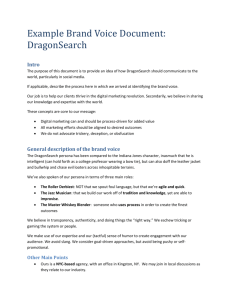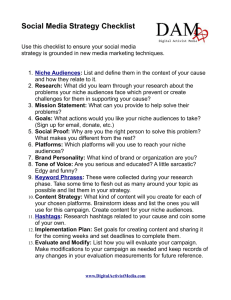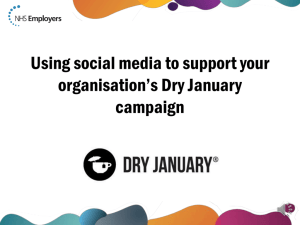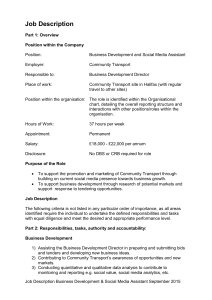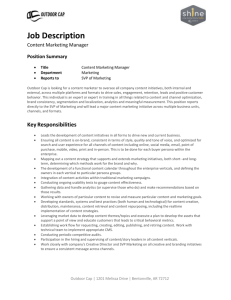Developing an effective social media strategy
advertisement
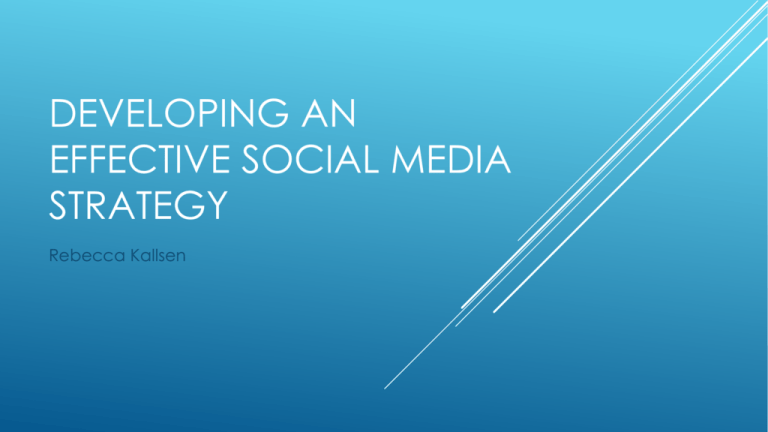
DEVELOPING AN EFFECTIVE SOCIAL MEDIA STRATEGY Rebecca Kallsen REBECCA KALLSEN • Communications & Public Relations Coordinator – 2014 OCHS • Public Relations Post-Grad Mohawk College • BA Child & Youth Studies – Brock University • Student Liaison – Canadian Public Relations Society • Public Relations Subcommittee – Hamilton HIVE • #HamOnt born and raised Which social media platforms do you use? CRASH COURSE: SOCIAL MEDIA 101 TWITTER • Micro blogging • Limits posts to 140 characters • Posts are called “Tweets” • Hashtags (e.g. #SayYes) • Mention (e.g. @2014OCHS) • 288 million active users FACEBOOK • Social sharing site • Create pages or profiles • “Friend” or “Like” people/pages • Photos, videos, articles, status, games, etc. • Users share 1 million links every 20 minutes • +1 billion active users world-wide INSTAGRAM • Social sharing site • Pictures & 15 second videos • Also uses #hashtags and @mentions • Companies using Instagram more often • Fastest growing social media platform • 200 million active users LINKEDIN • Business-focused networking site • Corporate brands, NFP, and individuals • Blog, search for jobs, build relationships • Powers almost half of the world's hires • 300 million users BLOGGER • • • • • • Discussion or informational site Blogging is your secret weapon Can relay an entire message – not constricted by length or type of content Blogs can be shared on other social media sites Over 409 million people view more than 18 billion pages each month blogger.com, blogspot.com, flickr.com, wordpress.com, weebly.com, blog.com WHY IS THIS IMPORTANT? Build a following Promote your brand Generate leads – i.e. participants, media, funding SM is becoming a major factor in the ranking algorithm for search engines like Google The more people you interact with on SM, the more searchable you’ll become on Google KNOW YOUR GOALS What are the goals of your research study and the Offord Centre? Every post should have a well-defined goal that supports your study or organization’s goals E.g. A Facebook post that pulls visitors to a participant page on your website: “Have you been contacted by Stats Can for the 2014 OCHS and want to learn more? Go to ontariochildhealthstudy.ca/participants” S.M.A.R.T. OBJECTIVES Specific, Measurable, Attainable, Realistic, Time-Bound Look at the situational analysis State objective in terms of outcomes of plans Bad objective: “To create awareness for the Offord Centre for Child Studies” – awareness is an outcome, not an objective Better objective: “To create participant awareness for the launch of the 2014 Ontario Child Health Study by securing 100 social media impressions by September 1, 2014.” – based on outcome of plan MEASURING SMART OBJECTIVES E-mail newsletter subscribers RSS subscriptions Retweets / likes Followers / Friends Stakeholder feedback Blog comments / social media discussion Traffic / analytics Ad clicks Sales and leads (participants gained) AUDIENCE Audience personality profile: Demographic, goals, interests, challenges (and how can you solve those problems for them?) ideas, what keeps them up at night, what social media platforms do they use? Use SM analytics to determine which social media platforms are best to reach your target audience ENGAGE YOUR AUDIENCE Two-way conversations SM is not about getting your message out to your audiences, it’s about building relationships with your audiences Don’t preach Engage and involve your audiences Reply to comments / questions promptly ENGAGE YOUR AUDIENCE Talk with people on SM about your expertise Speak their language Ask yourself, “Will my audience care about this content?” Focus on the benefits of the Offord Centre and the study People don’t buy a toaster based on how hot the heating elements can get, they buy it because it gets their toast done pretty fast in the morning so they aren’t late for work. • Heating element = feature • Fast toast = benefit • Focus on the benefit in a practical and clear way that your audience can understand KNOW YOUR COMPETITION Who are your biggest competitors? Make a list of the top 3-5 competitors What are they doing on SM? How do they engage with their audience? How do their followers respond? How can the Offord Centre or your research study stand out? CHOOSE YOUR PLATFORMS WISELY Managing 4-5 SM platforms is time-consuming Choose the SM platforms where your audiences spend their time If the majority of their time is spent on Twitter and Facebook, then those become your primary and secondary platforms Tweet 3-4 times/day, post on Facebook 1-2 times/day ESTABLISH ROLES Who will be managing the social media? Managing SM platforms is an integral part of your communications and public relations strategy for your studies Decide who is responsible and ensure that that person has the relevant skills and expertise Should not be given to a person if their only qualification is that they’ve used Facebook before This person needs to understand your goals and how to use SM to properly attain those goals CREATE A SOCIAL MEDIA CALENDAR weekly planning session works well Use a spreadsheet or website (www.hootsuite.com ) to capture, manage, and assign post creation tasks Benefit of using Hootsuite is that you can schedule SM posts as far in advance as you wish CREATE A SOCIAL MEDIA CALENDAR Still check SM sites daily to keep track and engage Include trending topics throughout the week E.g. breaking news, new research findings You become more likely to be discovered through “trending” topics CLEAR & CONSISTENT MESSAGE Clear message that attracts prospective audiences and encourages them to take action Make your message very specific What do you want to be known for? Message needs to articulate how your research solves a problem Specific benefit it delivers and how you differentiate yourself E.g. The largest study on children’s mental health in Ontario ANALYTICS Monitor and measure what’s working Evaluate your tactics against your objectives 5 suggestions: 1. Google Analytics 2. Hootsuite 3. Buffer 4. Sprout Social 5. Topsy QUESTIONS?
